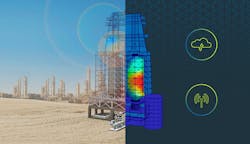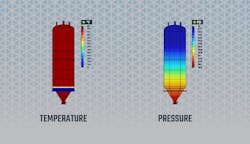Digital Twins in Refining: Breaking Down the Coking Process
Operating conditions within the process industry are typically harsh. The coking process in an oil refinery is a prime example.
The process subjects the coke drums to extreme temperature gradients and pressure swings over and over again, resulting in accumulated asset stress, fatigue, and, eventually, asset failure. That means coke drums will ultimately need replacement as there is no way to completely stop asset degradation across thousands of pressure and thermal cycles.
But, What if there was a way to understand and possibly reduce accumulated damage across time? The potential for expensive failures, unplanned, or even planned downtime to address asset health is one reason why operating companies are advancing their digitalization, or Industry 4.0, efforts and an area where a relatively small investment can help significantly reduce enterprise risk Digital twins, virtual representations of an asset, product or process, are among the technologies under the Industry 4.0 umbrella that chemical manufacturers are deploying to gain more insight into asset integrity.
How the Coking Process Works
The coking process involves feeding residual oil into a large, upright structure called a coke drum. Inside the drum, a process known as thermal cracking takes place, separating the oil into vapor and solid petroleum coke. This solid petroleum coke is used to produce fuel that helps power homes and communities and in various manufacturing processes such as steel and cement whilst overhead vapors are processed into higher quality transportation products.
Inherent Coker Drum Challenges
Replacing coke drums is invasive, time-consuming and expensive. Each drum can cost up to $10 million or more to replace, and downtime can significantly impact annual production targets and profit margins. Repairs are expensive and typically require expensive downtime. Asset integrity management tools and methods such as calendar-based inspections, laser scans, or risk-based programs that rely on an “average coker” behavior don’t provide clear visibility into the detailed specifics of when, why and how coke drums degrade, which poses significant challenges. For operators, this means they often can’t identify which cycles cause the most damage or, at best, are using average cycle damage profiles compiled as snapshots in time that are not reflective of reality.
Improved asset integrity management tools, that provide real-time insights can give operators a clear view of their coke drums, allowing them to reduce wear and tear, extend the asset's overall lifespan, and in some cases, find ways to help increase production.
Pan American Energy: Overcoming Coker Challenges Digitally
Pan American Energy, an oil and gas company based in Argentina, replaced two coke drums that had reached end of life. The company wanted to maximize the life of the new drums and avoid unnecessary asset degradation. To accomplish this, the company worked with an asset integrity management software provider to develop detailed models of the two drums using a combination of finite element analysis and machine learning. These models allowed Pan American Energy to see the mechanical dynamics of their coker drums in near real-time while in operation and see which cycles were causing the most damage.
Once the models were complete, engineers fed them with the cokers' real-time temperature and pressure data to create structural digital twins. These virtual representations can undertake thermal and stress analysis to identify areas requiring repair or which operating regimes caused the most structural damage down to the day/hour when the highest damage was created.
3 Takeaways for Pan American Energy
At the time of writing, the structural digital twins of the coker drum are fully operational. The company reported on the potential for three key benefits related to the deployment:
1. Throughput: A standard method of driving additional coker throughput is altering the preheat and quench cycles. However, prior to implementing the digital twin, operators didn’t have visibility into how they were impacting the drum on each cycle when making changes to preheat temperatures or durations and quench programs. By creating a digital twin of its coker drums, Pan American Energy can identify the varying levels of damage that have occurred, including drum-specific and process-specific damage events. The company also has same-day feedback on the impact on operational changes, such as increasing the speed of preheats to boost throughput, on equipment life. This level of information will enable operators to make informed tradeoffs between drum life and pushing the assets harder.
2. Downtime reduction: The digital twin demonstrated that not all coker cycles are identical. Less than 10% of the coker cycles accounted for more than 50% of the damage to the drums at critical locations. When Pan American Energy analyzed the two new coker drums, the digital twin found that the second drum suffered significantly more wear and identified the specific cycles where the damage occurred. Pan American Energy now has an “as-is” model of its asset, ready to use when unexpected events occur. The model enables proactive decision-making instead of waiting weeks or months for contracting and eventual offline and “average behavior” analysis.
3. Asset life extension: Rather than rely on overly conservative rules of thumb, digital twins ensure that Pan American Energy now makes informed decisions on maximizing coker life. The digital twins can ingest large quantities of operating conditions, calculate the coker's state and provide alerts. With this information, engineers can proactively adjust the operational envelope of the coker unit to reduce damage. They also can optimize scheduled inspection, maintenance and repair activities.
What Comes Next?
With digital twins, Pan American Energy can visualize cycle-by-cycle damage to address developing integrity issues before they escalate and unnecessarily reduce the drum's life. Since refinery assets are connected on a sitewide level, it makes the most sense to manage asset integrity across the whole refinery, maximizing the probability of catching defects early to avoid costly unplanned downtime. Digital twins can solve the obstacles facing refining and chemical plant operators. They provide a window to help operators optimize the management of their capital-intensive processes.
About the Author
Simon Sierra
VP Downstream, Akselos
Simon Sierra is a 20-year veteran of the refining and chemicals industry with global experience across process technology licensing, EPC, and industrial SAAS solutions, including machine learning, advanced analytics, and industrial optimization. He holds an undergraduate in Chemical Engineering and a Masters in Business with a focus on Technology and Finance from the University of Texas at Austin.


